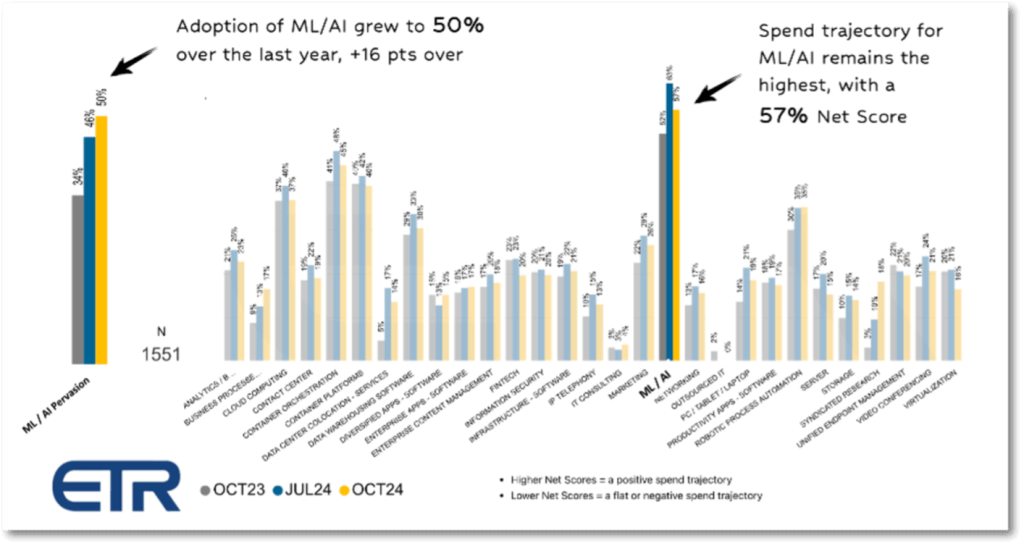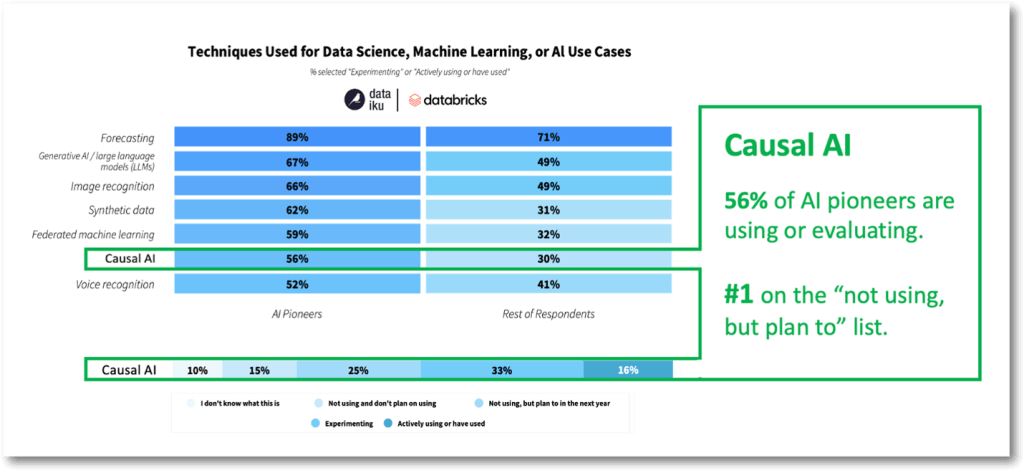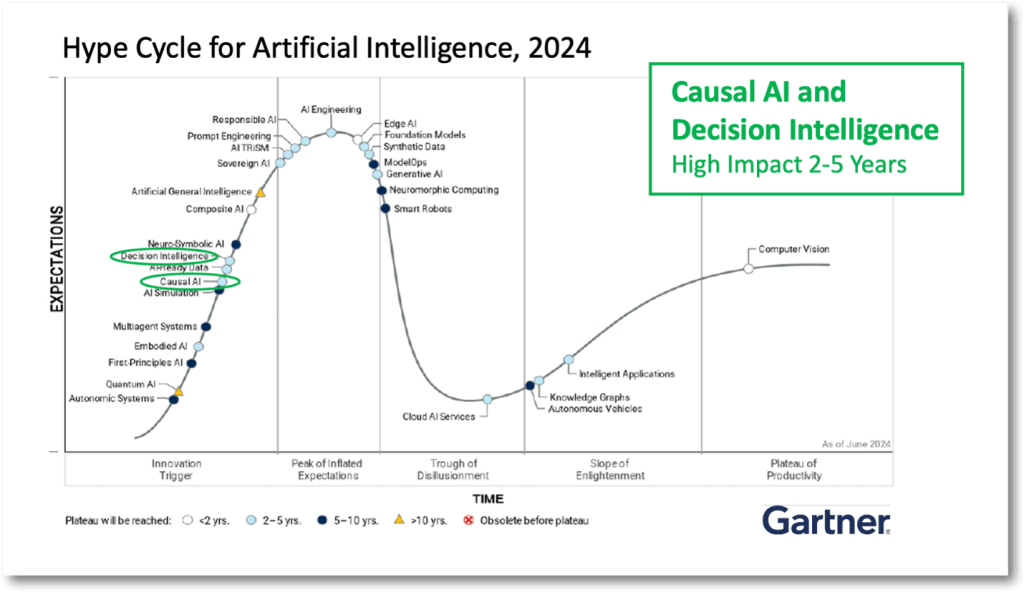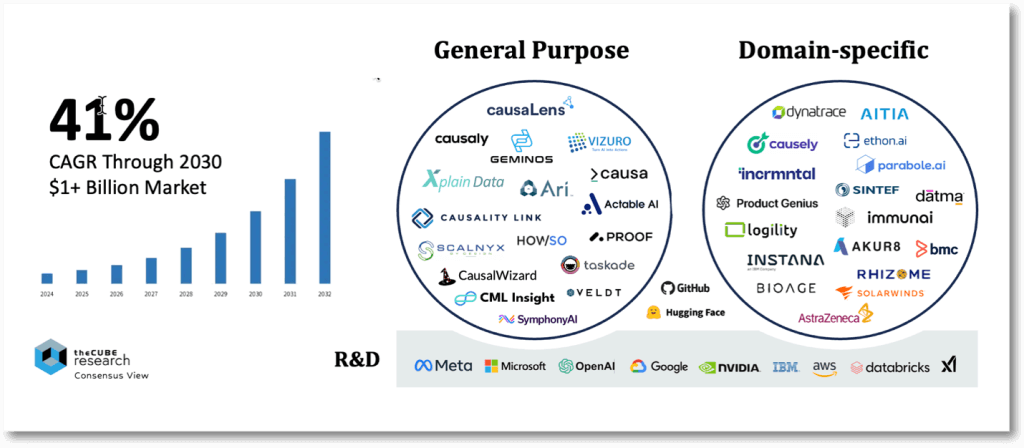Scott Hebner
2024-10-06 19:41:09
siliconangle.com
There is a missing ingredient in today’s artificial intelligence, which, when added, will make AI a truly indispensable partner in business and increase return on investment over the long haul.
The missing ingredient is causality and the science of why things happen.
Here at theCUBE Research, we are focused on informing you about the latest developments shaping AI’s future and helping you prepare now rather than later.
This research note is the first in a series exploring the emerging impact of causal AI. It will focus on the growing marketplace of products and services related to causal AI. Stay tuned for future notes that will progressively explain what you need to know and why.

Introduction
We believe that the rise of causal AI will play a vital role in enabling new high-ROI use cases within existing AI systems and future AI architectures. Overall, we are confident that integrating agentic AI, causal reasoning and interactive explainability, supported by a network of large language models and small language models, will define the next frontier of AI in business.
- LLMs deliver generally applicable generative AI services.
- SLMs deliver small, specialized and sovereign domain-specific models.
- Causal models infuse new levels of dynamic decision-intelligence.
- AI agents support humans in solving problems and executing tasks.

These future-state architectures will orchestrate an ecosystem of collaborating AI agents and models that will help humans problem-solve and make better decisions. They will also continuously teach each other to improve outcomes learned from real-world, outcome-based experiences. Causal AI will play a critical role in these architectures.
Furthermore, in the near term, the causal toolkit will help businesses progressively improve the outcomes rendered from today’s correlative AI models — generative AI, LLMs, predictive AI and the like — which operate based on statistical probabilities but often lack any genuine causal understanding. As a result, they cannot truly understand the dynamic nature of how a business operates, creates value and engages the world.
Despite that, today’s LLMs and generative AI are as incredibly impressive as they are complex. However, those in the middle of implementing causality in AI would tell you that it’s complex on a whole other level, involving the algorithmic application of some super-eloquent math and statistical theory.
Fortunately, as we will discuss, an increasing number of software companies is making significant strides in simplifying the use of causal AI for the masses. So, despite the almost unimaginable complexity behind the scenes, incorporating causality into today’s AI environment may be simpler than we realize and will likely become even easier over time.
For the purposes of this research note on the marketplace, let’s define causal AI as a branch of machine learning that emphasizes understanding cause-and-effect relationships rather than solely processing patterns in data. Though traditional AI models typically forecast or predict potential outcomes based on historical data, causal AI goes a step further by elucidating why something happens and how various factors influence each other.
In addition, causal AI can understand not only statistical probabilities but also how those probabilities change when the world around them changes, whether through intervention, creativity or evolving conditions. This is crucial because non-causal models perform well only if the future resembles the past. However, they struggle in a world of dynamic conditions, which is an inherent attribute of business.
Simply put, people are naturally inclined to understand “why” before taking action, making them causal by nature. It’s important for AI to also be causal by nature. The impact of causal AI on business could be enormous, as businesses rely on people to make decisions and act. After all, businesses don’t do things; people do.

The marketplace
There is little doubt that AI represents the transformative force of our time. This is why nine in 10 businesses are accelerating their spending on AI, with the vast majority declaring it their No. 1 investment priority. As a result, many organizations have already reported gains in productivity nearly three times above the overall 3% reported by the Bureau of Labor Statistics in 2023.
Though today’s AI capabilities are super-impressive, AI is only in its infancy.
To start, AI is an umbrella term. Many of today’s deployments are expert systems on steroids — the programmatic transfer of knowledge into rules-based systems. They do not employ the more capable algorithmic “brains” known as machine learning.
Of those who have, 80% rely on the least sophisticated techniques and can only perform narrowly defined tasks. This will change in the years ahead.
The global market for machine learning platforms and tools is projected to see substantial growth through 2030. According to estimates from theCUBE Research, the market is expected to reach $420 billion by 2030, with a compound annual growth rate of 35%. Cloud-based ML services, explainable AI, agentic AI and causal AI are anticipated to be major contributors to this expansion.
New Enterprise Technology Research survey data among 1550-plus decision makers supports the rapid adoption of ML and AI technologies within enterprise accounts. Half are already adopting ML, representing the highest spending trajectory among all technology categories.

This investment trajectory will likely continue as new tools and platforms democratize ML’s utilization across broader skill sets and, importantly, speed up the delivery of new ML advancements to the masses.
Despite the increased investment in AI, businesses still face limitations with today’s AI technology. According to a 2023 survey conducted by Rexer Analytics, fewer than half of enterprise machine learning projects make it into full production because of their inability to adapt to changing conditions, as well as a lack of trust and explainability.
However, there’s good news. Other studies, including a May 2024 survey by Dataiku, show that nearly seven in 10 AI projects that have made it into production experience a positive return on investment.
The emerging causal AI marketplace aims to address the limitations of current LLMs and generative AI solutions. This is particularly crucial for high-ROI use cases that depend on root cause detection, decision intelligence, problem-solving and autonomous action. AI professionals working on these cases recognize that integrating causality into the AI model lifecycle is essential for accurately modeling the dynamic business world and improving AI trust, transparency and explainability.

The marketplace is speaking louder and louder.
A survey of 400 senior AI professionals provided by Databricks Inc. showed that among AI pioneering companies, 56% were already using or experimenting with causal AI. In addition, among the total population of the survey, causal AI was ranked as the No. 1 AI technology “not using, but plan to next year.” The study reported that 16% are already actively using causal methods, 33% are in the experimental stage, and 25% plan to adopt. Overall, seven in 10 will adopt causal AI techniques by 2026.

We are also seeing more and more companies go public with their causal AI success stories, pilot projects, and lessons learned. Many of these are highly encouraged by its game-changing potential, with some already reporting quantified ROI.
For example:
- Georgia Pacific achieved a 10x increase in touchless order throughput by using causal AI to create a more seamless and adaptable order management process. They accomplished this by applying causal AI techniques to navigate the complexities of order management with greater precision, unraveling the cause-and-effect relationships to understand better how the business operates.
- McCann Worldgroup, a global leader in marketing strategies, achieved a 5% to 10% uplift in brand purchase intent by identifying causal drivers of complex and highly dynamic purchasing behaviors. Additionally, they were able to apply counterfactual reasoning to predict better the impact of potential initiatives and changes in consumer attitudes, offering a forward-looking view on brand strategy
- Urban Company, a provider of a marketplace that connects consumers in need of home services with trained professionals, has achieved more precise and accurate estimates of what affects its customers’ lifetime value metrics. This, in turn, allows them to apply “what if” interventions that quantitatively rank the impact of various actions, enabling them to optimize retention strategies.
- Instana, a provider of application performance and observability solutions, has applied causal AI to identify probable root causes as part of an intelligent incident remediation process. This allows system reliability engineers to resolve incidents by directly looking at the source of the problem instead of symptoms, saving them many hours of investigative work and reducing delays and costs to address the incident.

This surge in interest has driven the 2024 Gartner AI Hype Cycle to predict that causal AI will become a “high-impact” technology in the two- to five- year timeframe, a shift forward from the 2022 AI Hype Cycle that had it in the 5-10 year timeframe.
As per Gartner, causal AI is considered “crucial” for scenarios where it’s necessary to do more than just predict an outcome, but also understand the reasons behind the outcome and how to enhance it. Gartner also highlights that causal AI is essential for developing time-sensitive use cases that must function independently when human intervention is not possible. This entails AI understanding how to take action and the repercussions of its actions.
Furthermore, Gartner believes that the growing demand for increased trust, transparency, and explainability in AI results is fueling a rising interest in causal AI techniques because of their capacity to comprehend how outcomes are produced. Gartner concludes by stating that “The next step in AI requires causal AI.”
TheCUBE Research’s perspective on the report is that decision intelligence and causal AI should be combined in their hype cycle because decision intelligence without causality is simply business intelligence. We would also like to add that implementing causal models can be incremental, where no “rip and replace” is necessary. Lastly, the broadest application of causal AI is likely to occur within the context of SLMs (smaller, specialized, secure and sovereign) and as a component that powers agentic AI networks. However, we fully agree with Gartner on the critical importance of causal AI in future AI systems.

The resulting commercial marketplace is somewhat ill-formed, but we expect it to solidify and rapidly expand from here. The consensus view of six independent market studies complied by theCube Research indicates a projected 41% compound annual growth rate through 2030 to around a $1 billion marketplace.
Our view is that when assessing this marketplace, we must consider the following:
- In-house engineers are adopting and customizing open-source causal AI libraries, such as PyWhy, Salesforce Inc.’s causal AI library for the analysis of time series data, and Databricks’ causal incentive for customer incentive planning.
- Domain-specific app vendors are building causal AI methods into their products and services, such as drug research, supply chain optimization, IT operations, marketing management and investment planning. Some examples include Parabolie.ai for advanced manufacturing, Incrmntal for marketing mix optimization, and Aitia for next-gen drug discovery.
- AI heavyweights, including Meta Platforms Inc., Google LLC, Amazon Web Services Inc., OpenAI and IBM Corp., will likely add causal features to their core platforms and tools over time. They are all investing in causal AI research, which will likely lead to commercialization over time. Examples include IBM’s research into causally-augmented business processes (BP^C) and Microsoft Corp.’s research into human-interpretable explanations.
For these reasons, we believe the aggregate market impact of causal AI on business will be far greater than the $1 billion marketplace indicated by today’s studies. In fact, we would not be surprised to see a similar dynamic to how generative AI well outperformed its initial market growth projections and became the darling of the AI world.
It’s worth noting that numerous companies are already in this market, with hundreds, if not thousands, of customers. They are committed to providing both general-purpose and domain-specific causal AI tools and platforms, making AI causality’s high-ROI potential accessible to everyday businesses.
For example:
- CausaLens decisionOS provides a causal AI platform that focuses on automating the end-to-end data-to-decision workflow. The platform simplifies the entire process, starting from data ingestion to generating actionable insights that comprehend cause and effect. Its approach involves using AI agents to help businesses identify causal business drivers, develop causal AI models, and implement them through decision agents. Additionally, the platform offers prebuilt, customizable use cases and tools for integration with LLMs and gen AI.
- Geminos Causeway offers a powerful, low-code platform for developing causal AI apps and causal digital twins that can determine the reasons behind certain events. Causeway is based on open-source technology and offers a simplified solution for modeling causation and knowledge, along with advanced tools for causal analysis such as outlier, intervention and root-cause analysis. It also accelerates ETL (extract/transform/load) and data wrangling through more than 4,000 integrations, as well as the ability to enhance LLMs and gen AI investments.
- Causal-rnb’s Ari platform offers a cloud-based augmented intelligence platform that leverages causal ML techniques to simplify how businesses solve complex problems, particularly in the industrial sector. It streamlines the way business leaders perform data analysis, gather insights and tackle challenges. Ari enhances human intelligence by elucidating intricate data relationships and extracting actionable recommendations from vast datasets. It integrates causal discovery, causal inferencing, domain knowledge and the development of decision-making apps into a unified experience, enabling the discovery and interpretation of cause-and-effect relationships between variables within a complex system.
- CausaDB helps businesses understand how their systems and workflows function and provides guidance on the best actions to achieve improved outcomes. The tools provide a simple interface for creating, managing and deploying causal AI models and integrating them into existing software stacks with minimal effort. They have prioritized simplicity, ease of use, and speed, allowing your team to focus on what truly matters with smaller datasets.
- HowSo offers solutions that maximize AI ROI and reduce risks associated with traditional AI approaches through its Understandable AI Platform. This platform provides benefits such as a data-driven approach, transparency, auditability and bias reduction. It combines causal AI, synthetic data, attribution inferencing and model monitoring into one experience. The platform identifies causal relationships within datasets and quantifies cause-and-effect relationships through advanced causal inference and simulations, helping businesses make better decisions.
These are just a handful of solution providers in the marketplace today, and we fully anticipate that many more new entrants will soon emerge.

What to do and when
Causal AI is a significant advancement in the ongoing progression of AI. The current correlative-based designs have limitations that will eventually hinder the development of new innovations. As Microsoft Research has recently stated, “Causal machine learning is poised to be the next AI revolution.” Thugh it may not be a revolution, it is certainly necessary and inevitable. It’s just a matter of time before it becomes mainstream.
Perhaps the time is now to start preparing for this new frontier in AI. As we have witnessed in past technological evolutions, some will lead, some will lag and some will eventually fail. It’s never too early to start the evaluation process and run experiments.
We’d recommend you:
- Build a competency in Causal AI.
- Evaluate potential use cases.
- Experiment with the technology.
- Develop a future-state strategy.
- Contact us if we can help you on this journey.
We recommend watching the recent Breaking Analysis with Dave Vellante segment titled From LLMs to SLMs to SAMs: How Agents Are Redefining AI, which provides a holistic perspective on the value of causal AI. You can also listen to this on your favorite podcast channel.
Also, if you are a user of OpenAI’s ChatGPT, you may also find our recent research note OpenAI Advances AI Reasoning, But The Journey Has Only Begun of interest.
Finally, stay tuned for the next in this series of research notes on the advent of causal AI.
Image: theCUBE Research
Your vote of support is important to us and it helps us keep the content FREE.
One click below supports our mission to provide free, deep, and relevant content.
Join our community on YouTube
Join the community that includes more than 15,000 #CubeAlumni experts, including Amazon.com CEO Andy Jassy, Dell Technologies founder and CEO Michael Dell, Intel CEO Pat Gelsinger, and many more luminaries and experts.
THANK YOU
Support Techcratic
If you find value in Techcratic’s insights and articles, consider supporting us with Bitcoin. Your support helps me, as a solo operator, continue delivering high-quality content while managing all the technical aspects, from server maintenance to blog writing, future updates, and improvements. Support Innovation! Thank you.
Bitcoin Address:
bc1qlszw7elx2qahjwvaryh0tkgg8y68enw30gpvge
Please verify this address before sending funds.
Bitcoin QR Code
Simply scan the QR code below to support Techcratic.

Please read the Privacy and Security Disclaimer on how Techcratic handles your support.
Disclaimer: As an Amazon Associate, Techcratic may earn from qualifying purchases.

















































![[2024 Upgrade] INSAUTO Tesla Model Y Windshield Sunshade Umbrella-Protect Car from Sun…](https://techcratic.com/wp-content/uploads/2024/12/61aJHRkDWTL._AC_SL1392_-360x180.jpg)


















